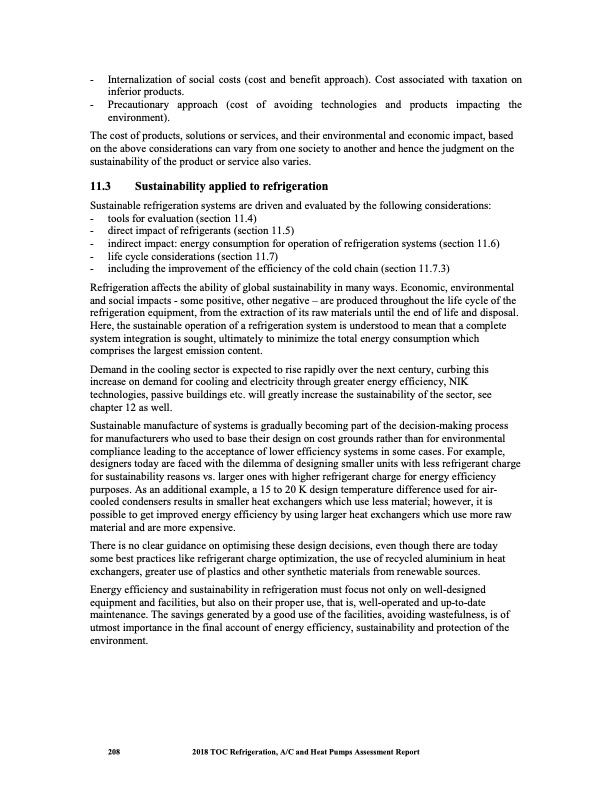
PDF Publication Title:
Text from PDF Page: 221
- Internalization of social costs (cost and benefit approach). Cost associated with taxation on inferior products. - Precautionary approach (cost of avoiding technologies and products impacting the environment). The cost of products, solutions or services, and their environmental and economic impact, based on the above considerations can vary from one society to another and hence the judgment on the sustainability of the product or service also varies. 11.3 Sustainability applied to refrigeration Sustainable refrigeration systems are driven and evaluated by the following considerations: - tools for evaluation (section 11.4) - direct impact of refrigerants (section 11.5) - indirect impact: energy consumption for operation of refrigeration systems (section 11.6) - life cycle considerations (section 11.7) - including the improvement of the efficiency of the cold chain (section 11.7.3) Refrigeration affects the ability of global sustainability in many ways. Economic, environmental and social impacts - some positive, other negative – are produced throughout the life cycle of the refrigeration equipment, from the extraction of its raw materials until the end of life and disposal. Here, the sustainable operation of a refrigeration system is understood to mean that a complete system integration is sought, ultimately to minimize the total energy consumption which comprises the largest emission content. Demand in the cooling sector is expected to rise rapidly over the next century, curbing this increase on demand for cooling and electricity through greater energy efficiency, NIK technologies, passive buildings etc. will greatly increase the sustainability of the sector, see chapter 12 as well. Sustainable manufacture of systems is gradually becoming part of the decision-making process for manufacturers who used to base their design on cost grounds rather than for environmental compliance leading to the acceptance of lower efficiency systems in some cases. For example, designers today are faced with the dilemma of designing smaller units with less refrigerant charge for sustainability reasons vs. larger ones with higher refrigerant charge for energy efficiency purposes. As an additional example, a 15 to 20 K design temperature difference used for air- cooled condensers results in smaller heat exchangers which use less material; however, it is possible to get improved energy efficiency by using larger heat exchangers which use more raw material and are more expensive. There is no clear guidance on optimising these design decisions, even though there are today some best practices like refrigerant charge optimization, the use of recycled aluminium in heat exchangers, greater use of plastics and other synthetic materials from renewable sources. Energy efficiency and sustainability in refrigeration must focus not only on well-designed equipment and facilities, but also on their proper use, that is, well-operated and up-to-date maintenance. The savings generated by a good use of the facilities, avoiding wastefulness, is of utmost importance in the final account of energy efficiency, sustainability and protection of the environment. 208 2018 TOC Refrigeration, A/C and Heat Pumps Assessment ReportPDF Image | Heat Pumps Technical Options

PDF Search Title:
Heat Pumps Technical OptionsOriginal File Name Searched:
RTOC-assessment-report-2018_0.pdfDIY PDF Search: Google It | Yahoo | Bing
CO2 Organic Rankine Cycle Experimenter Platform The supercritical CO2 phase change system is both a heat pump and organic rankine cycle which can be used for those purposes and as a supercritical extractor for advanced subcritical and supercritical extraction technology. Uses include producing nanoparticles, precious metal CO2 extraction, lithium battery recycling, and other applications... More Info
Heat Pumps CO2 ORC Heat Pump System Platform More Info
| CONTACT TEL: 608-238-6001 Email: greg@infinityturbine.com | RSS | AMP |